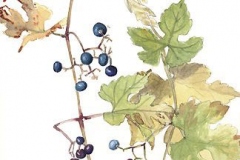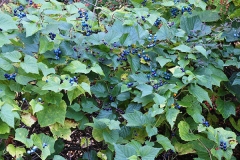| Porcelain berry Quick Facts | |
|---|---|
| Name: | Porcelain berry |
| Scientific Name: | Ampelopsis brevipedunculata |
| Origin | China, Korea, Japan and Russian Far East |
| Colors | Color changing from whitish, yellow, purple, turquoise, and porcelain blue |
| Shapes | Clustered drupes, shiny, spherical, to 0.5 inch (1.2 cm) wide, green tipped with a persistent pistil |
| Taste | Sweet, bitter |
| Health benefits | Beneficial for boils, abscesses, ulcers, traumatic bruises, aches, breast cancer and bleeding hemorrhoids |
| Name | Porcelain berry |
|---|---|
| Scientific Name | Ampelopsis brevipedunculata |
| Native | China, Korea, Japan and Russian Far East |
| Common Names | Porcelain Berry, Amur peppervine, Blueberry Climber, Porcelain Berry Vine, Creeper, Wild grape, Amur amelopsis |
| Name in Other Languages | Chinese: Dōng běi shé pú táo (东北蛇葡萄) English: Amur peppervine, Creeper, Porcelainberry, Wild grape, Amur amelopsis French: Vigne a fruits blues, ampélopsis à pédoncule court Germany: Amur- Scheinrebe; Ussuri- Scheinrebe; Ussuri- Zaunrebe Italy: Vite virgine Japanese: No-budô (ノブドウ) Russian: Ampelopsis korotkotsvetonozhkovyy (ампелопсис короткоцветоножковый), ampelopsis raznolistnyj (ампелопсис разнолистный), ampelopsis ussuriyskiy (ампелопсис уссурийский), vinogradovnik korotkonozhkovyy (виноградовник коротконожковый), vinogradovnik korotkotsvetonozhkovyy (виноградовник короткоцветоножковый), vinogradovnik raznolistnyy (виноградовник разнолистный), vinogradovnik ussuriyskiy (виноградовник уссурийский) |
| Plant Growth Habit | Vigorous, woody, deciduous, perennial tendril-climbing vine |
| Growing Climates | Thickets, forest edges, pond margins, stream banks, thickets, waste places, forest openings, roadsides and riverbanks |
| Soil | Prefers moist, rich soils and can thrive in a wide range of light availability |
| Plant Size | 15-20 ft. |
| Root | Woody, fibrous, large branched deep taproot |
| Bark | Bark has lenticels and does not peel or shred, while the stems bear white, continuous pith |
| Leaf | Alternate, simple and heart shaped in outline but variable in form from entire with 1 to 3 tips to those with multiple incised, rounded to scalloped lobes between 3 to 5 prominent whitish veins radiating from the base |
| Flowering season | July to August |
| Flower | Tiny, greenish-white flowers with petals separate at their tips occur in flat-topped clusters opposite the leaves; appear in summer |
| Fruit Shape & Size | Clustered drupes, shiny, spherical, to 0.5 inch (1.2 cm) wide, green tipped with a persistent pistil and contain two to four seeds each |
| Fruit Color | Turning whitish, yellow, purple, turquoise, and porcelain blue |
| Propagation | By seed and vegetatively from stem or root segments |
| Taste | Sweet, bitter |
| Plant Parts Used | Fruits, root, leaves |
| Season | October to November |
| Culinary Facts |
|
Plant Description
Porcelain berry is a vigorous, woody, deciduous, perennial tendril-climbing vine that normally grows about 15-20 ft. tall. The plant is found growing in thickets, forest edges, pond margins, stream banks, thickets, waste places, forest openings, roadsides and riverbanks. It is a hardy species that can adapt to a variety of environmental conditions, growing especially well in moist soils exposed to full sunlight or partial shade. It is however drought-tolerant and adaptable to poor soils of varying pH. In spite of its aggressiveness, it continues to be spread via the horticultural trade. Birds and other small mammals disperse its seeds, and evidence exists that water acts as a secondary method of dispersal. The plant has woody, fibrous, large branched deep taproot. It twines with the help of non-adhesive tendrils that occur opposite the leaves and closely resembles native grapes in the genus Vitis.
Stem
Woody vine to 4 inches (10 cm) diameter, climbing by tendrils with forked ends and fine hairs (tendrils not forked on native grapes). Tendrils occur on new growth, opposite leaves. New stems are whitish green, smooth to lightly hairy, slightly square with regularly spaced swollen nodes, increasingly with raised dots (lenticels) that become corky and reddish, eventually forming linear gray-reddish barky patches. Bark glossy light gray becoming gray and rough with persistent swollen nodes. Pith is white, while native grape pith is brown.
Leaves
Leaves are alternate, simple and heart shaped in outline but variable in form from entire with 1 to 3 tips to those with multiple incised, rounded to scalloped lobes between 3 to 5 prominent whitish veins radiating from the base. Margins are coarsely toothed with distinctive fine whitish hair tips. They are dark green to blue green, shiny above and fine hairy beneath, becoming yellow in fall. New leaves are tiny at branch tips, progressively increasing up to 6 inches (15 cm) long and 4 inches (10 cm) wide. Petioles are 2.5 inches (6 cm) long; light green and hairless, with greatly swollen bases. The plant climbs by tendrils that grow opposite the leaves on the stem.
Flower
The perfect flowers are protandrous (anthers open before stigma is receptive), borne in cymes opposite the leaves on peduncles 1-2.5 cm long and pedicels 1-3mm long. There are 5 green sepals. The 5 free greenish-white petals are 0.8-1.8 mm long and ovate-elliptic. There are 5 stamens. The ovary is adnate to an enlarged disk and the style is described as conspicuous, whereas the stigma is inconspicuous. Flowering normally takes place in between July to August.
Fruits
Fertile flowers are followed by clustered drupes, shiny, spherical, to 0.5 inch (1.2 cm) wide, green tipped with a persistent pistil and turning whitish, yellow, purple, turquoise, and porcelain blue (thus the common name), with all colors sometimes present.. Each fruit contains 2-4 seeds and each plant can contain hundreds of berries. The fruits appear in between September and October.
Traditional uses and benefits of Porcelain berry
- Fresh fruits, roots and leaves are anti-phlogistic, depurative and febrifuge.
- It is used externally in the treatment of boils, abscesses and ulcers, traumatic bruises and aches.
- Stems and roots were traditionally used as anti-inflammatories, diuretics, and anti-hepatotoxins by the Chinese.
- It has been reported to inhibit liver injury caused by over exposure to carbon tetrachloride.
- It is also used to treat breast cancer.
- Compresses or poultices made from the leaves and roots have been used in the treatment of bruises, boils, burns and other minor skin problems.
- Decoction of the roots is also used to alleviate bleeding hemorrhoids.
Control
Once porcelain berry is established it is extremely difficult to control, and eradication is doubtful. Recommended control methods for porcelain berry tend to be labor intensive and/or may be slow to show effects. Porcelain berry’s potential for long-range seed dispersal and ongoing intentional planting of it, reviews by make control more difficult.
Fire: No information is available on the use of prescribed fire for porcelain berry control at the time of this publication.
Prevention
Preventing the establishment and spread of porcelain berry has not been discussed in the literature; however, concern in the literature over porcelain berry’s ongoing use for landscaping suggests that restricting the sale of porcelain berry may reduce future establishment and spread.
It is commonly argued that the most cost-efficient and effective method of managing invasive species is to prevent their establishment and spread by maintaining healthy natural communities and by monitoring several times each year. Managing to maintain the integrity of the native plant community and alleviate the factors enhancing ecosystem invasibility is likely to be more effective than managing solely to control the invader.
Cultural control
Shading has been recommended as a means for controlling porcelain berry. Planting fast growing trees such as tulip-poplar and red maple, or allowing existing trees to mature, may shade out porcelain berry, provided trees are kept free of its vines. Shading may control porcelain berry best when used as a part of an integrated management plan.
Physical or mechanical control
Porcelain berry vines can be pulled down from trees. Cutting or mowing may control porcelain berry particularly after its vines have been pulled down from trees but repeated treatments are necessary to prevent sprouting. Because it prevents flowering, cutting may be most effective in the fall or spring. Repeated mowing may reduce porcelain berry’s vigor. One review indicated that porcelain berry’s root system cannot be dug out.
Biological control
Based on a literature review, Ding and others identified porcelain berry as one of a group of invasive species from Asia most in need of a biological control. Four natural enemies were identified as potential biological controls for porcelain berry, but as of this writing nothing more has been published.
Chemical control
Porcelain berry may be controlled with herbicides such as triclopyr or glyphosate. One review recommended a foliar application of glyphosate in early autumn to be the most effective control for porcelain berry. Basal bark applications of triclopyr formulated for use with penetrating oil control porcelain berry, but precaution must be taken not to harm other woody species. Experimental treatments to control porcelain berry indicated that herbicides controlled porcelain berry when used in conjunction with mowing. It has been suggested that large porcelain berry vines be targeted for broad applications of herbicide and smaller vines be spot-sprayed.
Herbicides are effective in gaining initial control of a new invasion or a severe infestation, but they are rarely a complete or long-term solution to weed management. See the Weed control methods handbook for considerations on the use of herbicides in natural areas and detailed information on specific chemicals.
Integrated management
Based on preliminary field testing, Robertson recommended cutting porcelain berry to the ground and treating stumps with herbicide to gain initial control of porcelain berry, followed up with a dense planting of fast growing trees that may eventually shade out porcelain berry. He recommended that hand-pulling or herbicide spot-spraying be used to control subsequent sprouting.
References:
https://www.itis.gov/servlet/SingleRpt/SingleRpt?search_topic=TSN&search_value=28632#null
https://pfaf.org/user/Plant.aspx?LatinName=Ampelopsis+brevipedunculata
https://www.invasive.org/alien/pubs/midatlantic/ambr.htm
https://www.cabi.org/isc/datasheet/4815
https://plants.usda.gov/home/plantProfile?symbol=AMBR7
https://gd.eppo.int/taxon/AMCBR











